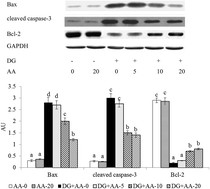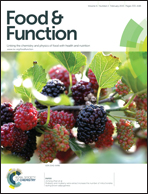Anti-apoptotic and anti-glycative effects of asiatic acid in the brain of d-galactose treated mice
Abstract
Protection of asiatic acid (AA) in mice brain against D-galactose (DG) induced aging was examined. AA at 5, 10 or 20 mg kg−1 per day was supplied to DG treated mice for 8 weeks. AA intake at 10 or 20 mg kg−1 per day increased its deposit in brain. DG treatment increased Bax, cleaved caspase-3 protein expression and decreased Bcl-2 expression. AA intake at 10 and 20 mg kg−1 per day declined Bax, cleaved caspase-3 expression, and retained Bcl-2 expression. DG treatment decreased brain glutathione content and glutathione peroxidase activity; increased brain reactive oxygen species and protein carbonyl levels, and enhanced NAPDH oxidase expression. AA intake at test doses reversed these changes. DG treatment up-regulated the expression of advanced glycation end product (AGE), carboxymethyllysine, receptor of AGE (RAGE), mitogen-activated protein kinases and CD11b as well as increasing the interleukin (IL)-6 and tumor necrosis factor (TNF)-alpha release in the brain. AA intake at 5, 10 and 20 mg kg−1 per day lowered AGE and carboxymethyllysine expression, and at 10 and 20 mg kg−1 per day reduced RAGE production. AA intake dose-dependently suppressed p-p38 expression and lowered IL-6 and TNF-alpha levels, and at 10 and 20 mg kg−1 per day down-regulated p-JNK and CD11b expression. DG treatment declined brain-derived neurotropic factor (BDNF) expression and raised glial fibrillary acidic protein (GFAP) expression. AA intake at 20 mg kg−1 per day retained BDNF expression and at 10 and 20 mg kg−1 per day reduced GFAP expression. These findings indicated that the supplement of asiatic acid might be beneficial to the prevention or alleviation of brain aging.

- This article is part of the themed collection: Alzheimer's Research Month 2016

 Please wait while we load your content...
Please wait while we load your content...